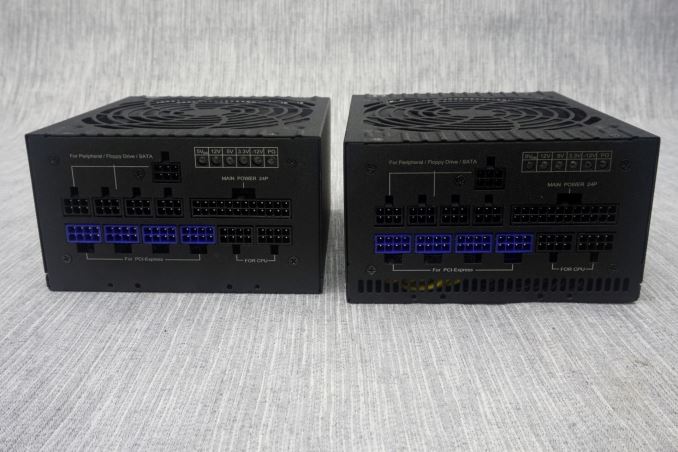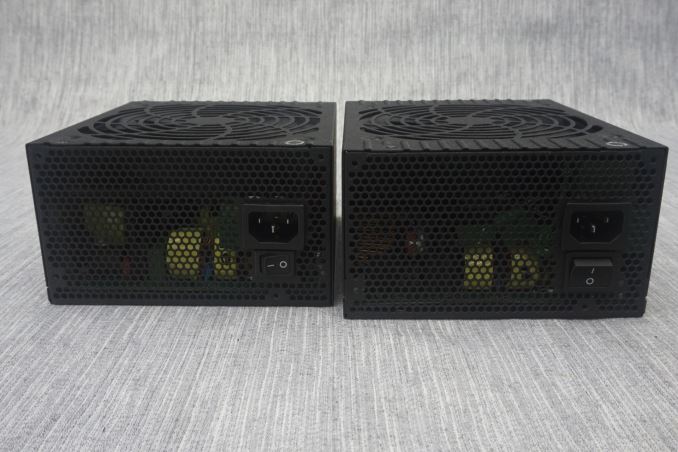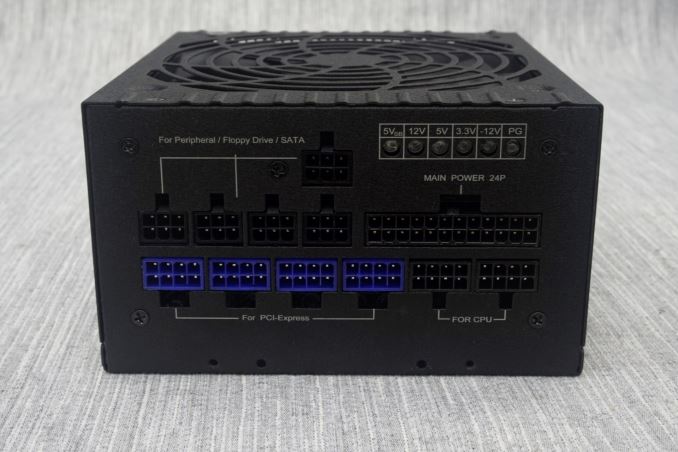The Rosewill Quark Series Power Supply Review (750W, 850W, 1000W, 1200W)
by E. Fylladitakis on January 13, 2016 9:00 AM EST- Posted in
- Cases/Cooling/PSUs
- Rosewill
- 80Plus Platinum
External Appearance
Rosewill went with the common "black goes with everything" approach for their Quark series units. The otherwise simple chassis is sprayed with a textured black paint that creates a sandstone-like visual effect. Instead of installing a removable finger guard, Rosewill cut the top cover to resemble a warped spider's web. There are no stickers or decorations on the sides of the chassis, the sticker with the specifications of the PSUs is placed at the top side of the units. The three most powerful Quark PSUs share the same exact chassis, while the 750W version is only slightly shorter.
The rear side of the PSUs is relatively uninteresting, with just a typical on/off switch and an AC power cable connector to be found there. Perhaps the only noteworthy observation is that the 750W unit has a smaller switch, as the larger units naturally have to cope with a larger input current.
While it is not strange for the rear side of these PSUs to be very similar, their front sides are peculiarly identical as well. All of the units share the same number of connectors, even though the smaller units do not come with enough cables for them. All of the connectors are black, with the exception of the PCI-Express connectors, which are blue. There are also six self-test LEDs near the top, five for the main voltage lines and one for the "Power Good" signal. These can be used to diagnose basic PSU issues.
Internal Design
Another difference between the 750W Quark and the more powerful versions is the fan. The 750W version has a Yate Loon D14BH-12 fan installed, a very powerful 140 mm fan, with a ball bearing engine and a maximum rotational speed of 2800 RPM. For the more powerful models, Rosewill went with a slightly smaller Young Lin Tech model, the DFS132512H, a 135 mm fan with a "hybrid" self-lubricating bearing and a maximum rotational speed of just 1700 PRM. Why Rosewill is installing such a powerful fan in the smaller models eludes us, as units capable of 80Plus Platinum efficiency with such a power output do not require these levels of airflow.
A glance on the insides of the Quark series PSUs instantly reveals that the 750W version is based on a similar, yet different platform than the rest. All are made by Enhance Electronics, with the 750W based on the 13XX Platinum platform and the more powerful units on the boosted 13XX Platinum GT platform. The 750W version has similar but notably smaller heatsinks and main transformer, while the secondary conversion stage MOSFETs can be seen from the top side of the main PCB, next to the transformer. The three larger PSUs have a larger secondary side heatsink and the secondary conversion MOSFETs are placed underneath the main PCB.
There is virtually no design difference between the 850W, 1000W and 1200W PSUs. Only the size and suppliers of the components change, with the mere exception that the 850W PSU has one input bridge rectifier and the larger units have two, with an extra smaller heatsink sandwiched between them.
The filtering stage of the 750W version consists of four Y capacitors, two X capacitors, two filtering inductors and a surge suppression MOV. Panasonic supplies the APFC 450V/560μF capacitor and all of the secondary side electrolytic capacitors come from Nippon Chemi-Con. Teapo supplies the polymer capacitors.
Enhance boosted the filtering stage of the 850W-1200W units slightly by adding two extra X capacitors. Rosewill's choice of component suppliers with these three models is very messy, hinting that the company is using whichever supplier is available and cost-effective at the time. The 850W version has its 420V/330μF primary capacitors supplied by Matsushita, its secondary side electrolytics are a mix of Nichicon, Unicon, Nippon Chemi-Con and Rubicon products, with Teapo supplying the polymers. The 1000W version came with two Nippon Chemi-Con 450V/390μF APFC capacitors, a mix of Nichicon, Unicon, Nippon Chemi-Con and Rubicon electrolytic capacitors, with Teapo and Dura Tech supplying the electrolytics. Finally, the 1200W version comes with Matsushita 420V/470μF APFC capacitors, a mix of Unicon, Nippon Chemi-Con, Nichicon and Dura Tech electrolytics, and another mix of Teapo, Nichicon and Dura Tech polymer capacitors.









































34 Comments
View All Comments
Mushkins - Wednesday, January 13, 2016 - link
I was super excited for a Rosewill product with this kind of quality thats *fully modular*, right up until I saw the price point. A Corsair CX750M is about $85 and frequently goes on sale for less or includes $10-15 rebates. Granted it's only 80+ Bronze rated, but the practical differences between a Bronze and a Platinum unit are very small, if not totally meaningless for most people, and certainly isn't worth a $45+ price premium.Honestly, I think Rosewill missed the mark with these pushing for that Platinum rating.
xthetenth - Wednesday, January 13, 2016 - link
They're part of a line, and while the cheap high end is a somewhat limited market, they've got the lower end parts covered, and up until the top if they hit their pricing targets they'll be selling their platinums against other companies' golds and so on down the chain.bigboxes - Wednesday, January 13, 2016 - link
You need to compare these PSUs (pricewise) to other platinum power supplies. If that is out of your budget you can always buy a bronze rated Rosewill if so inclined.zero2dash - Wednesday, January 13, 2016 - link
You're comparing a budget model PSU to a non-budget model PSU. Do you also compare Chevy to Porsche? McDonald's dollar menu to Five Guys?You should instead be comparing this PSU to Corsair HXi and AXi if you want apples to apples.
wolfemane - Wednesday, January 13, 2016 - link
Yes Chevy has been compared to porche for a long time. Corvette and camero come to mind. Price per horse power has put the corvette ahead of more expensive porches. And at those costs, built quality in both are as good as porche but with far lower maintanen costs (and fewer trips to the shop).I think the original comment still stands. On paper these drives have some differences, but in real world application the cheaper psu operates at near or same performance as the premium psu.
So one can brag about owning a porche, but next to a stingray their gonna be smoked and left realizing the only bonus to their more expensive hardware is image. As for me, I'll happily save money and make a porche driver frown.
tuxRoller - Wednesday, January 13, 2016 - link
You're right. A stingray would be left smoking on the railing if it tried to stay with a Porsche on a twisty track.devione - Thursday, January 14, 2016 - link
Really? The ZR1 is only 1+ second slower than a 911 GT2.devione - Thursday, January 14, 2016 - link
On the Nurburgring that is.catzambia - Monday, January 25, 2016 - link
I've run Nordschliefe in 5 minutes in my civicwolfemane - Thursday, January 14, 2016 - link
ZR1 - $70k911 GT2 - $120k
ZR1 (hell even the Z06) has a better 0-60 and 0-100, same times around test tracks, better insurance rating, better maintenance time lines (and a whole lot cheaper), and gets better gas milage.
The ZR1 is faster, quicker, and can corner better than any Porsche at the same price point. It might take Americans a lot longer to figure out how to make a true sports car out of an aging muscle car, but the Corvette is there.
Let me also point out the new style Corvettes (99 and newer) have won 6 LeMans in the past 12 years. That track has corners, and Porsche does compete int he same class. That's a pretty good track record, and one that hasn't been broken yet.